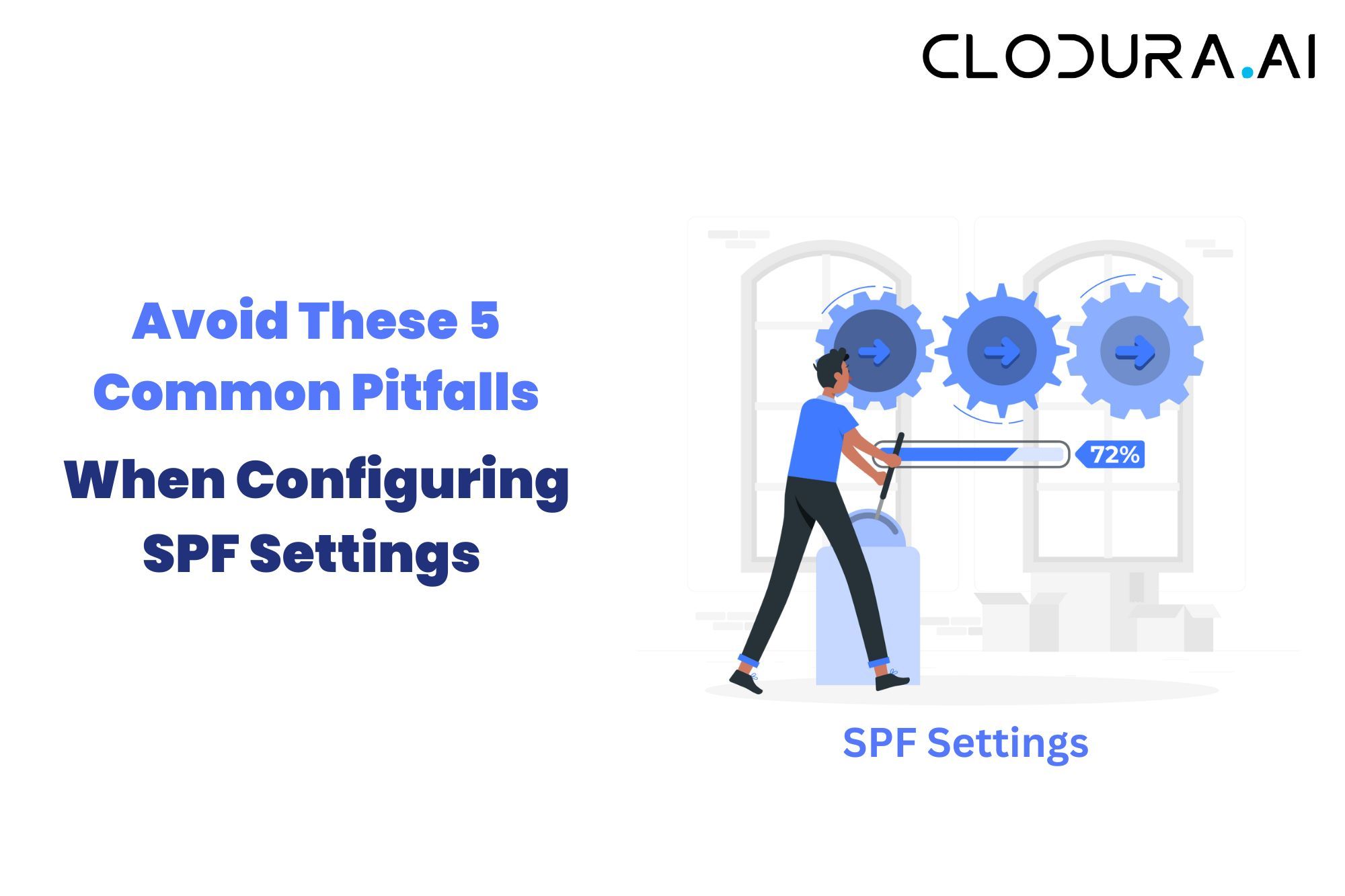When it comes to configuring SPF settings, avoiding common pitfalls is essential for ensuring the security and deliverability of your emails. From overlooking DNS record updates to improper syntax, the complexities of SPF settings can lead to a multitude of challenges for even the most seasoned IT professionals.
In this blog, we'll unravel the five most prevalent pitfalls that organizations encounter when configuring SPF settings, providing you with actionable insights to sidestep these issues.
Navigating the intricacies of SPF configuration demands attention to detail and a comprehensive understanding of best practices to mitigate the risk of SPF authentication failures. By addressing these potential missteps proactively, you can fortify your email infrastructure's security and bolster the reliability of your outgoing messages.
Join us as we delve into the common pitfalls and equip you with the knowledge to overcome them, safeguarding your email communication from unnecessary disruptions. Whether you're a seasoned IT administrator or a business owner overseeing your email configurations, being aware of these common pitfalls is paramount to maintaining a secure and efficient email ecosystem.
Understanding SPF Configuration Basics
Before delving into the common pitfalls, it is crucial to grasp the fundamental concepts of SPF configuration. SPF, which stands for Sender Policy Framework, is a validation system designed to prevent email spoofing, which is commonly used in phishing attacks. By publishing SPF records in your Domain Name System (DNS) settings, you specify which mail servers are authorized to send emails on behalf of your domain.
SPF records consist of a series of mechanisms and qualifiers that define the sending policy for your domain. These mechanisms include IP addresses, hostnames, and external services. Each mechanism has its own qualifier, which specifies how the mechanism should be evaluated. The most commonly used qualifiers are:
|
SPF checks whether the IP address of the sending server matches the authorized mechanisms in your SPF record. If there is a match, the email passes the SPF authentication. However, if there is no match or if the SPF record is not found, the email may be marked as potentially fraudulent or rejected by the recipient's mail server.
When configuring SPF, it is important to consider the following:
● Include all authorized mail servers:
Make sure to include all the mail servers that are authorized to send emails on behalf of your domain in your SPF record. This ensures that legitimate emails sent from those servers are not marked as spam.
● Specify the correct mechanisms:
Choose the appropriate mechanisms based on your mail server infrastructure. If you use a third-party email service, you may need to include their SPF mechanisms in your record.
● Regularly review and update your SPF record:
As your mail server infrastructure changes, it is important to review and update your SPF record accordingly. This helps maintain the accuracy and effectiveness of your SPF configuration.
By understanding the basics of SPF configuration and following best practices, you can enhance the security of your email communication and protect your domain from email spoofing attacks.
Common Pitfalls in Configuring SPF Settings
Despite its importance, many administrators encounter challenges when configuring SPF settings. By understanding and avoiding these common pitfalls, you can ensure the effectiveness of your SPF configuration:
Pitfall 1: Incorrect SPF Syntax and Structure
The syntax and structure of an SPF record must follow specific guidelines to function correctly. Many errors occur due to misplacement of mechanisms, incorrect syntax, or missing qualifiers. It is vital to carefully verify the SPF syntax and structure to avoid any validation errors.
For example, a common mistake is forgetting to include the "v=spf1" tag at the beginning of the SPF record. This tag indicates that the record is an SPF record and is necessary for proper validation.
Another common error is misplacing mechanisms within the SPF record. Each mechanism should be placed in the correct order, starting with the most specific and ending with the most general. Failing to follow this order can lead to incorrect SPF validation.
Furthermore, it is crucial to include all necessary qualifiers, such as "all" or "redirect," to specify the action to be taken if the SPF check fails. Omitting qualifiers can result in unexpected behavior and potential email delivery issues.
Pitfall 2: Failure to Include All Authorized Mail Servers
One of the key purposes of SPF is to specify which mail servers are authorized to send emails on behalf of your domain. Failing to include all authorized servers in your SPF record can result in legitimate emails being marked as spam. Ensure that you list all your authorized mail servers in the SPF record to avoid delivery issues.
It is important to regularly review your mail server infrastructure and identify all the servers that are authorized to send emails for your domain. This includes both internal servers and external services that you may use for email delivery.
Additionally, consider any future changes or additions to your mail server infrastructure. If you plan to add new servers or switch to a different email service provider, make sure to update your SPF record accordingly to include these authorized mail servers.
Pitfall 3: Overlooked Third-Party Services and Email Senders
Many organizations rely on third-party services and email senders for various purposes. These services often send emails on your behalf, such as marketing campaigns or transactional emails. To ensure the successful delivery of these emails, it is crucial to include these third-party services in your SPF configuration.
Identify all the third-party services and email senders that are authorized to send emails on behalf of your domain. This may include marketing automation platforms, customer support systems, or any other service that interacts with your customers via email.
Once you have identified these services, check if they provide specific instructions or guidelines for configuring SPF records. Some services may require you to add their SPF records as include mechanisms in your own SPF record. Following these instructions will help ensure that emails sent through these services are properly authenticated and delivered.
Pitfall 4: Lack of Regular SPF Record Monitoring and Updates
Keeping your SPF records up to date is essential to maintain optimal email deliverability. Over time, mail server IP addresses and authorized services may change. Failing to monitor and update your SPF records accordingly can result in emails being rejected or marked as spam. Regularly review and update your SPF records to stay aligned with your mail infrastructure.
Set up a regular schedule to review your SPF records and check for any changes in your mail server infrastructure. This can include monitoring IP address changes, server migrations, or updates to your email service providers.
Additionally, stay informed about any changes or updates in the SPF specification itself. The SPF standard may evolve over time, and new mechanisms or syntax may be introduced. Keeping up with these changes will help ensure that your SPF records remain compliant and effective.
Pitfall 5: Misconfiguration of SPF Records for Subdomains
When configuring SPF, it is essential to include SPF records for all your subdomains. Each subdomain may have different mail servers sending emails on behalf of it. Neglecting to configure SPF records for subdomains can lead to delivery failures or improper SPF validation. Guaranteed email delivery requires correctly configuring SPF for both the primary domain and all subdomains.
Take inventory of all your subdomains and identify the mail servers associated with each subdomain. Create separate SPF records for each subdomain, specifying the authorized mail servers for that particular subdomain.
Remember to include these subdomain SPF records in the DNS configuration for each respective subdomain. This ensures that SPF checks are performed correctly for emails sent from subdomains, preventing any authentication issues and potential delivery failures.
Regularly review your subdomain SPF records to ensure they are up to date. If you add or remove mail servers for a subdomain, make sure to update the corresponding SPF record accordingly.
By avoiding these common pitfalls and following best practices for SPF configuration, you can enhance the deliverability and security of your email communications. Remember to regularly review and update your SPF records to adapt to changes in your mail server infrastructure and ensure optimal email delivery.
What to Expect After Configuring SPF Settings
Once you have properly configured and published your SPF records, you can expect increased email deliverability and improved protection against email spoofing. SPF, which stands for Sender Policy Framework, provides a reliable framework for email authentication, reducing the chances of your legitimate emails being marked as spam or phishing attempts.
When you configure SPF settings correctly, you establish a list of authorized mail servers that are allowed to send emails on behalf of your domain. This means that when an email is received, the recipient's mail server can check the SPF record to verify if the sending server is authorized to send emails for your domain. If the sending server is not listed in the SPF record, the recipient's mail server may treat the email as suspicious or even reject it.
By implementing SPF, you not only protect your domain from email spoofing but also help maintain a positive reputation for your domain. When your emails consistently reach the intended recipients, it builds trust and credibility for your organization or business.
However, it's important to note that SPF is just one piece of the email authentication puzzle. To ensure comprehensive protection, SPF should be implemented alongside other email authentication protocols such as DMARC (Domain-based Message Authentication, Reporting, and Conformance) and DKIM (DomainKeys Identified Mail).
DMARC helps prevent email spoofing by providing a policy framework that allows domain owners to specify how email receivers should handle unauthenticated emails. It works in conjunction with SPF and DKIM to provide a layered approach to email authentication and protection against phishing attacks.
DKIM, on the other hand, adds an additional layer of security by digitally signing outgoing emails. This signature can be verified by the recipient's mail server, ensuring that the email has not been tampered with during transit.
By combining SPF, DMARC, and DKIM, you create a robust email authentication system that significantly reduces the risk of your domain being used for malicious purposes. It not only protects your organization's reputation but also helps safeguard your customers and partners from falling victim to email scams.
Conclusion
Avoiding the common pitfalls discussed in this article will help you configure SPF settings correctly. Understanding SPF configuration basics, including authorized mail servers and third-party services, and regularly monitoring and updating your SPF records are crucial steps to ensure successful email deliverability and maintain a trustworthy email infrastructure. Remember, email security is an ongoing process, and staying informed about the latest best practices is essential to keep your domain safe from email threats.
FAQs
Q: What is the most common mistake when configuring SPF settings?
Neglecting to include all relevant mail servers in the SPF record.
Q: How does SPF affect email deliverability?
Proper SPF configuration enhances email deliverability by preventing unauthorized sources from sending emails on behalf of your domain.
Q: Can I have multiple SPF records for a single domain?
No, it's recommended to have a single SPF record containing all authorized mail servers to avoid conflicts.
Q: What happens if I exceed the SPF DNS lookup limit?
Exceeding the SPF DNS lookup limit can result in SPF failures, impacting email authentication. Keep the record within the 10 DNS lookup limit.
Q: Is it necessary to periodically review and update SPF settings?
Yes, regular reviews and updates are crucial to accommodate changes in your mail infrastructure and ensure continued effectiveness of SPF configurations.


